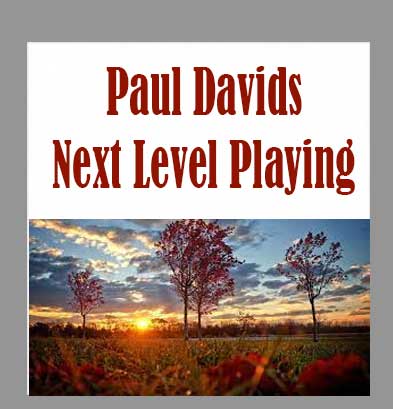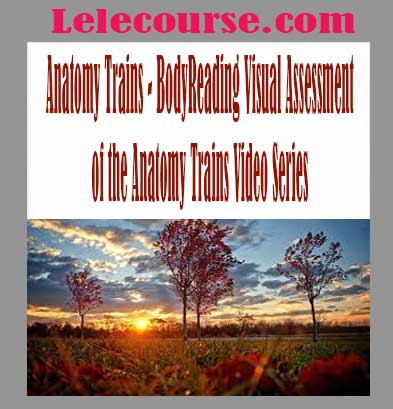Description
Next Level Playing with Paul Davids
For Intermediate Guitarists
A strategic and fun 7-level roadmap to level up your playing with over 35 video lessons, including PDFs with tabs, downloadable backing tracks, original solos, and more
How to Take your Guitar Playing to the Next Level
The path to becoming a well-rounded guitarist who can confidently improvise, create your own sound, and jam with other musicians.
From the Studio of Paul Davids
Rotterdam, The Netherlands
It takes a lot to learn the guitar.
When you’re first starting out, your fingers don’t go where you want them to, your skin gets callused, and you can’t even play a clean chord without the strings buzzing.
But then after a lot of practice, you reach your first big milestone: being able to play your first song.
It feels like a huge accomplishment.
But, in a way it’s also just the beginning of your journey as a guitar player, so you continue on.
You learn more chords, you learn different notes and scales, and maybe you learn how to read tabs or chord sheets.
Over time, with patience and consistency, you get better and better.
After a few years, you have dozens of songs in your repertoire, you can nail your favorite licks from beginning to end, and you can even play along with a group as long as it’s a song you know.
But then, progress starts to slow down…
When You Stop Making Progress
I have seen firsthand how many dedicated guitarists reach a point in their voyage where they begin to feel stuck, having spent over a decade in the studio as a guitar teacher.
They begin to experience a sense that they are no longer developing or progressing as participants.
Additionally, it appears that the practice regimen that was previously effective in enhancing and refining their playing abilities is no longer producing any outcomes.
Despite the fact that the majority of intermediate players practice assiduously, they frequently encounter the following:
- They have been practicing the same types of music for years without achieving a deeper level of understanding and fluidity.
- They aspire to transcend the confines of memorization and mere performance of melodies; however, they are unable to freely express themselves and generate new ideas.
- They are capable of jamming to music they are familiar with, but they experience feelings of discomfort or uncertainty when they are asked to collaborate with other musicians on unfamiliar tunes.
- Their desire is to be able to improvise and “noodle,” but they are reticent to attempt it and are unsure of how to do so.
- They possess a basic understanding of theory and scales, but they are unable to apply them in a practical manner to enhance their creativity in their performance.
If any of those statements sound somewhat familiar, there is no need for concern; this sentiment is shared by numerous proficient intermediate players.
However, what is the reason for this?
Why do you experience a sense of stagnation as an intermediate player, despite the fact that you make significant progress at the outset?
When “Practicing” is No Longer Sufficient
Technical proficiency and repetition are the primary concerns at the outset.
Being consistent and diligent is the key.
However, progress beyond the intermediate level necessitates more than simply practicing the same song until it is perfected.
The subsequent level of guitar proficiency transcends the mere acquisition of a tune, the mastery of a strum pattern, or the memorization of a solo.
In order to…
Extract your guitar and engage in a contemplative state…
Compose your own compositions and enhance well-known music with your own noises…
Or participate in a jam session with friends, contributing to the group’s compositions without restriction, regardless of whether they are traditional or entirely improvised.
…you must transcend your previous practice regimen and progress beyond the monotony of viewing the same videos.
In order to elevate your playing to a new level, you must alter your practice routine beyond merely altering the material you practice. You must also alter your approach to practice.
This is comparable to the experience of attempting to improve one’s physical condition through an exercise regimen:
If you have been exercising for a few months or years, you may be able to make more progress by varying the types of exercises you perform, rather than simply increasing the weights and reps of the same exercises you have been performing for months.
In the same vein, it is insufficient to simply practice a difficult composition, riff, or lick in the same manner in order to continue making significant progress on the guitar.
In order to advance to a more advanced level of musicianship, you will need to modify your practice strategy now that you are an intermediate player.
Naturally, you will persist in your attention to the actions of your fingertips.
However, it will also be necessary to push your intellect and concentrate on new areas in order to develop into a well-rounded musician.
The Good News Is… …with dedication and guidance, any intermediate guitarist can overcome the sensation of being “stuck in a loop” and progress to the next level of playing, even if they have been playing for years or even decades without making significant progress.
It is possible to enhance one’s hearing.
You can acquire the ability to compose your own music, whether it involves improvising solos, incorporating your own style into chords, or simply performing riffs to unwind.
And you can become so accustomed to the fretboard that you will feel at ease jamming with friends, certain that you will locate the appropriate notes and chords at the appropriate time.
However, in order to embark on the journey to this form of musical creativity, it is necessary to comprehend…
Three Keys to Unlocking the Next Level on Guitar
In music, everything is connected
1. Connections are a foundation for creativity
Of course, getting better at guitar takes practice, but more importantly, it requires a deeper understanding of music.
In music, everything is connected.
And learning about these connections and understanding the “how” and “why” behind the music actually makes it possible to become far more expressive and creative.
For example, once you understand how chords and scales relate to each other within a given key, you can:
- Know exactly which scale to use as a guide for choosing notes when you’re “noodling” in that key – which means the music you make up will sound like a perfect fit
- Have a logical foundation for figuring out what chords are being used in songs you hear (especially when chord sheets so often have errors)
- Easily transpose chord progressions into different keys in your head, instead of having to use online chord transposition tools
In connecting your knowledge of theory to your technical skills, you’ll have a much greater command of the fretboard and be able to easily find the notes and chords you’re looking for.
This combination of technique and understanding will help you become a well-rounded guitar player, and even though it might sometimes seem a bit dry or “technical,” it is the path to more creativity and freedom on the guitar.
2. Improvisation is a skill that can be developed
Of all of the skills that make you feel like a “real guitarist,” being able to improvise is right at the top of the list.
But it can also feel mysterious and intimidating – and incredibly awkward to try in front of other people. In fact, many players have a secret fear: that because improvisation doesn’t come naturally to them, they might not have enough talent to do it at all.
The truth is, improvising is actually a skill that can be practiced and developed, step by step.
With an understanding of those practical connections between scales and chords, plus some strategies for using them to build your improv “chops,” you can become confident at improvising, whether you’re playing at home or soloing at a jam session with friends. And you’ll be able to play with intentionality, finding the notes and chords that go along with whatever key you happen to be in.
Anyone can develop and improve their improvisation skills
I’ll show you how to maximize your practice time and get the most from it
3. You need a roadmap for your practice
Many intermediate players practice by going down various “trails” on the Internet…
They watch some music theory videos in one place, learn a new riff from another place, and get chord charts from somewhere else.
And even though they are learning some interesting things, it’s hard to “connect the dots” between the various things and apply it to their guitar playing in a practical way.
Plus, in order to make progress on the guitar, you actually need to challenge yourself in new ways, which means working on things you aren’t good at yet or haven’t spent much time developing.
But this can be a difficult thing to do on your own, because it’s natural to gravitate toward the things that come most easily or feel most comfortable.
As a result, many players end up putting in the hours, without actually doing the things that will pay off in the long run.
This means that, in order to take your playing to the next level, you need a step-by-step “roadmap” – a resource to give you direction to take the right steps, in the right order.
And, you need guidance to challenge yourself in new ways, so you don’t fall into the same old patterns or well-worn routine.
It’s once you hone in on the areas that require improvement (such as technique, ear training, improvisation, and theory), and strategically focus on strengthening them that you’ll be able to reach the next level in your personal evolution as a guitarist.
Experiencing the enjoyment that guitar has to offer
I hope you can start to see that becoming a real next-level guitarist is a goal that is possible for anyone, as long as you have the right roadmap in place and are committed to the journey.
And with the resource I’m about to share with you, you will have the guidance necessary to allow you to move to the next level – even if you have been “stuck” for years.
Of course, it requires commitment, but it’s well worth the effort it takes to get there.
And it’s once you follow this path that you’ll be able to “unlock” experiences like these:
- You’re hanging out with friends who happen to be musicians too, and you’re able to grab your guitar and start confidently jamming along with them, even if you’ve never heard the song before.
- You’re at home on a rainy day, and you can sit by the window and pass the time “noodling” on your guitar to express how you’re feeling, without having a specific song to play.
- You’re trying out a new song by your favorite artist, and you’re able to find the notes and chords all over every part of the fretboard like it’s second nature.
- You pull out your guitar at a gathering of friends and family and start to impress people with just some random playing in the background.
- You’re playing along to one of your favorite songs, and you can add your own sound to it, making up new riffs and solos by ear, just for fun.
It’s at this level of playing that chords and notes become connections, the fretboard feels like home, and the guitar becomes your voice.
It’s a milestone well worth reaching…
Hi, I’m Paul Davids
I first picked up the guitar when I was 12 years old. I was a kid with a red Squier and dreams of playing like Green Day, Metallica, and a local band called “de Heideroosjes.”
These days, I really enjoy teaching guitar and helping other people experience the same creative joy that’s brought me so much pleasure over the years.
It’s why I started my personal channel on YouTube, which has grown into a pretty popular guitar channel with over three million subscribers from all over the world!
On the channel, I share all the things that interest me, based on what I’ve learned from over two decades of playing, songwriting, and producing.
I received a music degree, with a minor in teaching guitar, from Rotterdam Conservatory.
And in 2018, I took a big step and created a resource to teach fundamental guitar skills to hundreds of students online through my beginner-level guitar course, Learn, Practice, Play.
Though I initially didn’t know what to expect, the response to the course was overwhelmingly enthusiastic, to a degree well beyond what I had ever hoped for.
And throughout the process of putting out my beginners’ course, I received messages from thousands of intermediate guitarists who wanted help making progress to reach the next level of playing.
So with many months of work, I put together an online course just for intermediate guitarists, to provide a strategic roadmap for becoming well-rounded, fluent musicians.
Introducing…
My course for intermediate guitarists designed to help you break through to a new level of freedom and confidence in your playing…
… And become a well-rounded guitarist who doesn’t just play songs, but can create your own music, express yourself fluidly, and jam with other musicians.
Understand, Play, Create
Inside Next Level Playing, we’ll use three aspects of guitar playing in each level of the course, all designed to help you have fun and learn how to express yourself more freely on the guitar.
- Understand: You’ll learn the “why” behind every note, chord, interval, fingering, and technique so that you can stop the endless loop of playing by rote and understand what you’re playing.
- Play: You won’t just memorize theoretical principles and strategies; you’ll put them into practice with fun songs and riffs – supported by energizing backing tracks – and have a blast playing every day.
- Create: After connecting the dots with theory and practicing new skills, you’ll be ready to start creating your own sounds, improvising new riffs and noodles, and spicing up your favorite songs with your own personal touch.
Next Level Playing provides you with the step-by-step guidance you need… and then challenges you to start creating music for yourself.
Building Your Guitar Skills “Toolkit”
While working through this self-paced course, you will:
- Build your skills “toolkit” with systematic, strategically planned lessons that connect new skills and knowledge, giving you the freedom to create your own sound
- Understand the theory behind how chords and scales are connected, and use them in practical ways as a creative springboard to improvise, play solos, or create your own songs
- Gain confidence using your entire fretboard, and know how to find notes and chords easily in any position
- Become fluent in the “language” of music so you can more easily communicate and collaborate with other musicians
- Start improvising with scales and chords as basic building blocks, and then use artistic techniques to make your improv more expressive and completely natural
- Learn seven original solos, including the “how” and “why” behind every note and scale so you can gain confidence playing solos and even writing your own riffs
- And, you’ll be able to “get” other guitarists on a deeper level, whether it’s understanding every video on my YouTube channel or following along in John Mayer’s live chats.
Here’s What You’ll Learn Inside Next Level Playing…
In Level 1, you’ll learn:
- Ways to find notes quickly, anywhere on the fretboard
- Better barre chord technique
- What chord progressions mean and how to work out which chords to play
- How to play major and minor chords everywhere on the neck
- The major scale and how we use it in improvisation
In Level 2, we’ll be looking at:
- How knowing one simple scale (the pentatonic) can be enough to play great solos
- Improving your bending technique and making it sound better
- Why triads are important, and different ways to play them
- Adding licks to your playing whenever and wherever
- How to play a solo and improvise in a minor blues
In Level 3, you’ll learn:
- How 7th chords can spice up your chord progressions
- How the neck is constructed by shifting licks up and down the neck
- How to transpose a chord progression into a different key
- Increasing your speed and accuracy across the fretboard with the pentatonic scale
- The Aeolian mode: the minor scale
In Level 4, we’ll cover:
- Becoming a faster, more versatile player with “3 notes per string” scales
- How to give chords a “solo” feel by adding embellishments
- Creating a unique sound by learning how to use the harmonic minor scale
- Incorporating triads and voice leading into your playing
- Learning a cool solo that uses the harmonic minor scale and coming up with your own version
In Level 5, I’ll show you:
- One of the biggest secrets to my playing: how I keep in time
- Fretting techniques you can use to give your chords a new sound
- How to use Dorian mode, which you hear a lot in blues, funk, and pop
- My picking technique, and different positions for arpeggios
- How to give your chords a fresh sound using hammer-ons and pull-offs
In Level 6, you’ll learn:
- How to play chords like Hendrix, Frusciante, and Mayer
- How the CAGED system can help you navigate the fretboard
- Breaking out of that pentatonics box by playing “diagonally”
- What target notes are, and how they can make your solos stand out
- A great solo in a 6/8 time signature combining many skills we’ve learned
In Level 7, I’ll show you:
- A great option for playing lead over 7th chords (it’s the “Mixolydian mode”)
- How to play extended chords (with the 9th, 11th, and 13th intervals)
- How to nail 12-bar blues rhythm and solos
- How to play blues shuffles and blues rhythm guitar
- How to mix your techniques and keep your solos interesting
4 Next-Level Bonuses
Bonus #1: Ear Training 101
If there is one thing I regret about my early years of playing guitar, it’s that I didn’t do more ear training, so I’ve included bonus ear training exercises for each level of this course. In each level, you’ll listen to me play some riffs, licks, or chords. Your job is to work out what notes I’m playing. (And of course, I’ll give you the answers in the next module so you can see how you did!)
That way you can start simple and then train your “ear” in progressively challenging ways. Before long, you will start to see results like being able to:
- Identify notes and chords just by listening to a song
- Transcribe any guitar solo into a different key
- Play the song ideas that are in your head
- Jam with friends more easily
I promise that if you practice ear training regularly, you will understand the guitar much, much better. You’ll begin to hear things you never heard before!
You’ll develop an ear for notes and chords like never before!
You’ll be improvising in no time
Bonus #2: Improvisation Tutorial
One of the best things about playing guitar is being able to improvise, whether it’s for noodling on your own or making up some cool licks and solos when you’re jamming with other musicians. And so, in addition to the fundamental aspects of improv woven throughout the course, I’ve put together a bonus tutorial with my top recommendations for making your improvisation sound more interesting and enjoyable to listen to.
In this video, you’ll get my personal improv strategies, including:
- How to instantly sound more experienced, and make your improvisation sound much more expressive
- My simple strategy for turning wrong notes into enjoyable features of your playing – in a way that sounds like you did it on purpose
- How to give your improvised solos space and structure so that they will draw people in and hold their attention, while also sounding great
- And more!
Refund is acceptable:
- Firstly, item is not as explained
- Secondly, Next Level Playing do not work the way it should.
- Thirdly, and most importantly, support extension can not be used.
Thank You For Choosing Us! We appreciate it.









Reviews
There are no reviews yet.